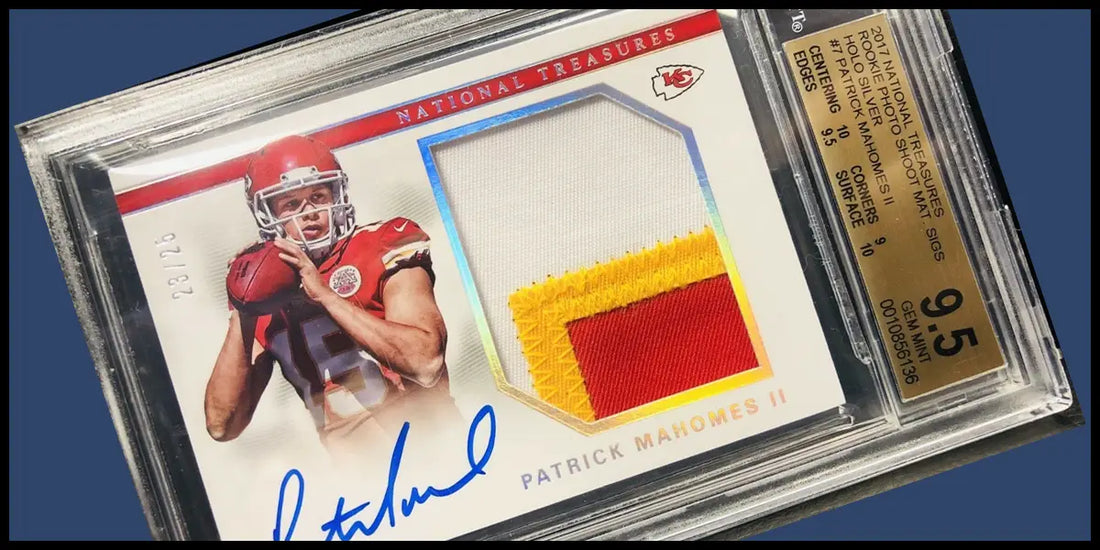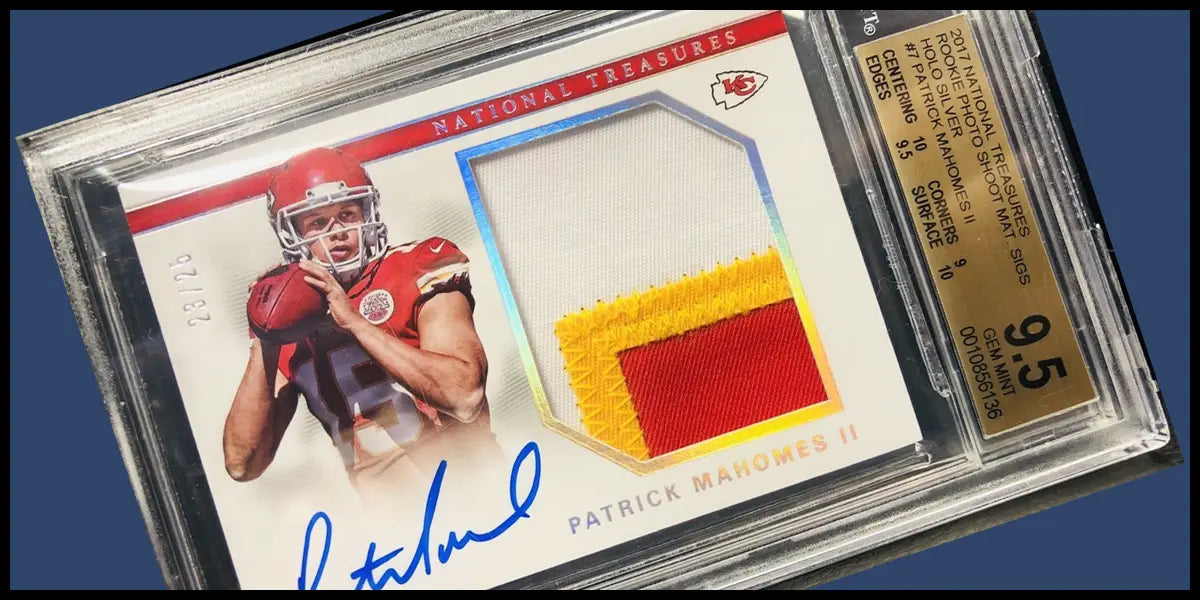
What Does Rpa Stand For In Sports Cards?
Share
If you’re a passionate sports card enthusiast, you may have stumbled upon the acronym RPA and thought, “What does RPA stand for?” Well, worry not, because I’m here to unravel the mystery behind this captivating abbreviation. RPA stands for “Rookie Patch Autograph,” a term bursting with significance in the vibrant world of sports card collecting.
In the realm of sports collectibles, rookie cards are the jewels of any collection. These coveted cards feature athletes in their inaugural year of professional play, holding a special thrill for collectors. But what truly elevates an RPA’s status is the pairing of a patch—often a piece from the player’s game-worn jersey—with an autograph from the athlete themselves. The patch adds a unique, tangible element, while the autograph brings an intimate connection between the collector and the player.
So, when you encounter a card labeled as an RPA, you know you have stumbled upon something truly extraordinary. These remarkable cards intricately weave the allure of a rookie player with the exceptional nature of a patch and the authenticity of a player’s autograph. As a result, they don’t just attract attention; they are highly prized by collectors and often command jaw-dropping prices in the market.
Now that you understand what RPA stands for, it’s time to embark on a thrilling journey into the fascinating world of sports card collecting. Brace yourself as we dive deeper into the captivating stories wrapped around these treasured collectibles. Join me as we explore the intricate nuances of this hobby and uncover the secrets behind the RPA phenomenon!
RPA stands for “Rookie Patch Autograph” in the realm of sports cards. This term refers to a unique type of card that features both a patch from a player’s jersey or equipment and their signature, typically released during their rookie year. RPA cards are highly sought after by collectors due to their rarity and the exceptional combination of a player’s autograph, rookie status, and a piece of authentic memorabilia. Often, these cards showcase the player’s team logo or jersey number, enhancing their value among enthusiastic collectors.

What Does RPA Stand for in Sports Cards?
If you are an avid collector of sports cards, you may have come across the intriguing term RPA. But what exactly does RPA stand for, and why is it pivotal in the sports card collecting universe? RPA stands for Rookie Patch Autograph. It specifically denotes a type of card that flaunts a patch of a rookie player’s jersey, complemented by their autograph. Collectors covet these cards due to their scarcity and intrinsic value.
Among the vast spectrum of sports card collecting, rookie cards hold a unique reverence. They signify the very first cards of a player embarking on their professional career and often mature into valuable investments as time passes. RPA cards amplify this allure, merging the rookie card prestige with a distinct piece of the player’s jersey and their personal autograph. Together, they form an exceptional collectible that's hard to resist!
What Makes RPA Cards Special?
RPA cards stand out as some of the most valuable and sought-after treasures in the sports card collecting community. Several defining factors contribute to their elevated status:
Rarity:
Typically, RPA cards are produced in limited quantities, making them rarer than many other types of sports cards. This scarcity, combined with high demand from collectors, sends their value soaring in the competitive market.
Authenticity:
The inclusion of a player’s autograph along with a patch from their jersey imparts a level of authenticity that distinguishes RPA cards from the pack. The personal touch of an athlete’s signature, paired with a piece of their on-field gear, creates a tangible link to their legacy.
Investment Potential:
Thanks to their appealing rarity and the ongoing popularity they maintain, RPA cards promise solid investment potential for collectors. As rookie players carve their names into the annals of sports history, the worth of their RPA cards can experience significant increases. Thus, collectors often view these cards as promising long-term investments that could yield substantial returns.
How to Identify RPA Cards
Navigating the expansive sports card collecting landscape and spotting RPA cards can be daunting, especially for beginners. However, keeping an eye on a few essential characteristics can streamline your search:
Player Designation:
RPA cards usually showcase a prominent rookie designation, signaling that it is indeed the player’s first-year card. This can be indicated through a specific logo or descriptive text on the card itself.
Patch and Autograph Placement:
The presence of both a jersey patch and a distinctive autograph confirms the card's RPA status. Typically, the patch takes center stage, prominently displaying a section of the player’s jersey, while the autograph is wisely placed to grab attention.
Card Manufacturer:
Certain sports card manufacturers are noted for producing RPA cards more frequently than others. A bit of research into different manufacturers and their offerings can significantly aid collectors in identifying potential RPA gems.
With this newfound understanding of what RPA stands for in the world of sports cards, you can truly appreciate the significance and allure of these one-of-a-kind collectibles. Whether you’re an experienced collector or just taking your first steps into this exhilarating hobby, RPA cards provide thrilling and potentially lucrative additions to your growing collection. So, keep a lookout for these extraordinary cards and relish the excitement they bring to sports card collecting!
Key Takeaways: What Does RPA Stand for in Sports Cards?
Frequently Asked Questions
What is RPA in sports cards?
RPA stands for Rookie Patch Autograph in the dynamic world of sports cards. This term refers to a specific card type that showcases a patch of the player’s jersey or other memorabilia alongside the player’s autograph. With their rare combination of a player’s rookie status, signature, and game-worn patch, RPA cards are incredibly appealing to collectors.
Recently, RPA cards have surged in popularity, especially in the sports trading card market. Offering an exciting, tangible connection to the athlete, these cards become invaluable pieces in any collector's trove. The fusion of a player’s autograph and a fragment of their game-used gear makes RPA cards exceptionally desirable.
Why are RPA cards so highly valued?
RPA cards achieve high value for several compelling reasons. Firstly, they commonly feature a player’s autograph, injecting a personal essence that enhances the card’s collectibility. Secondly, the jersey patch, originating from a player’s game-worn equipment, adds layers of rarity and uniqueness, capturing a moment in time connected to the player’s career.
The limited production runs of RPA cards serve to heighten their desirability further. This combination of rookie status, player’s autograph, and game-worn memorabilia produces a trifecta of appeal, resulting in RPA cards being aggressively sought after within the sports card hierarchy.
How can I identify an RPA card?
Identifying an RPA card isn’t as tricky as it may seem if you know what to seek. Begin by checking for a player’s autograph, most commonly displayed somewhere on the card. Additionally, search for a patch
